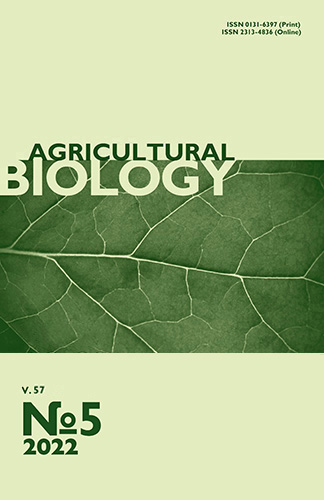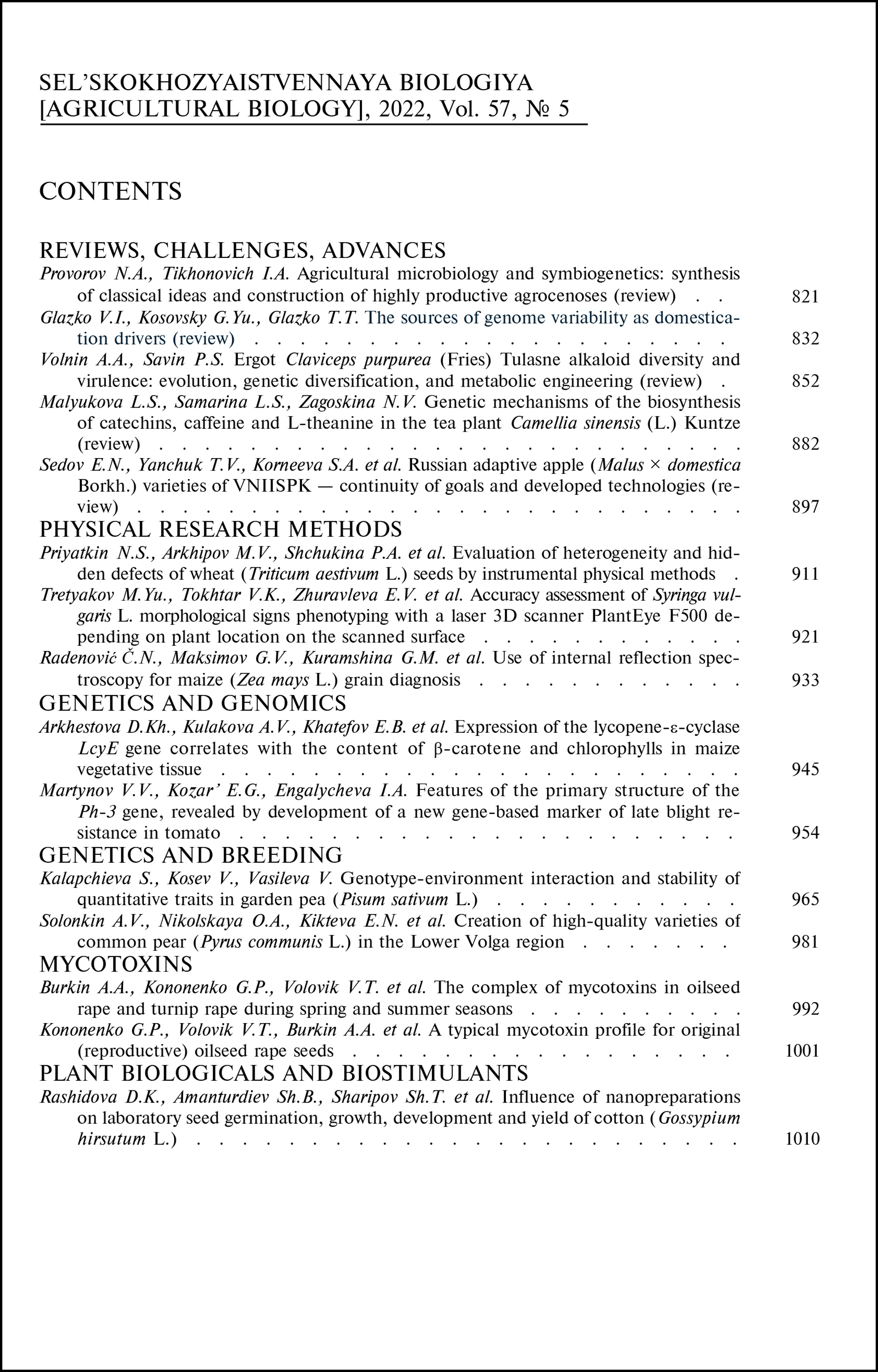doi: 10.15389/agrobiology.2022.5.954eng
UDC:635.64:631.52:577.21
Acknowledgements:
The work was carried out within the framework of State Assignment No. 0431-2022-0004.
FEATURES OF THE PRIMARY STRUCTURE OF THE Ph-3 GENE, REVEALED BY DEVELOPMENT OF A NEW GENE-BASED MARKER OF LATE BLIGHT RESISTANCE IN TOMATO
V.V. Martynov1 ✉, E.G. Kozar’2, I.A. Engalycheva2
1All-Russian Research Institute of Agricultural Biotechnology, 42, ul. Timiryazevskaya, Moscow, 127550 Russia, e-mail martynov.vik@gmail.com (✉ corresponding author);
2Federal Research Center for Vegetable Growing, 14, ul. Selektsionnaya, pos. VNIISSOK, Odintsovskii district, 143072 Russia, e-mail kozar_eg@mail.ru, engirina1980@mail.ru
ORCID:
Martynov V.V. orcid.org/0000-0003-1784-3429
I.A. Engalycheva orcid.org/0000-0003-4843-111Х
Kozar’ E.G. orcid.org/0000-0002-1319-5631
Received July 1, 2022
Late blight caused by the oomycete Phytophthora infestans (Mont.) de Bary is one of the most harmful diseases of tomatoes. Late blight control remains challenging due to the high genetic variability and complex racial composition of P. infestans. Therefore, the most promising method of combating late blight is the breeding of resistant varieties of tomato. When creating resistant varieties, the introgression of resistance genes from wild-growing related species is widely used. In particular, several late blight resistance genes identified in the wild tomato species Solanum pimpinellifolium have been introgressed into tomato cultivars. Among these genes, the Ph-3 gene is considered to be the strongest late blight resistance gene, as it provides resistance to a variety of P. infestans isolates. Therefore, considerable efforts of scientific groups around the world are directed to the study of this gene in order to include it in breeding programs and introduce it into new commercial varieties and lines of tomato. To date, DNA markers associated with this gene are known. However, homologues of this gene were found in the tomato genome, which do not have functional activity. Analysis of the multiple alignment of the nucleotide sequences of the Ph-3 gene and its homologues showed that the primers used in the known markers for amplification of this gene are in the conservative regions of these sequences, and it is impossible to specifically amplify the Ph-3 gene with them. Therefore, the aim of this work was to design a new highly specific marker of the Ph-3 gene and compare it with already known markers by analyzing the collection of tomato varieties of the Federal Scientific Center for Vegetable Growing for the presence of known and new markers and assessing the linkage of these markers with resistance to late blight disease in the studied varieties. To this end specific primers were designed (5′-AATATTGAAAATAGCTGCACTGA-3′/5′-CGAGATTTGGAGGGAATGTAA-3′) that discern the Ph-3 gene from its homologues and amplify a 412 bp gene fragment (the Ph3-412 marker). Using these primers, 24 tomato (Solanum lycopersicum L.) varieties bred at the Federal Scientific and Technical Center and tested for late blight field resistance (Federal Scientific and Technical Center, Moscow Province, 2021) were analyzed. Also, these varieties were analyzed with known marker NC-LB-9-6678. To determine the nucleotide sequence of the new marker, we cloned the amplified product obtained from the studied varieties into pAL-TA vector and sequenced the resulting clones. In addition, we cloned and sequenced 601 and 907 bp fragments obtained with a known marker. We compared the nucleotide sequences of all three fragments with the sequences of the prototype gene and its known homologues. As a result, we confirmed that the fragment amplified using primers designed by us belongs to the Ph-3 gene, while the 601 bp fragment obtained with the known primers corresponds to the SlRGA4 homologue, and the 907 bp fragment obtained with the same primers is homologous to the Ph-3 gene but it contains an insertion of the LTR retrotransposon of the Ty1-copy family with a size of 306 bp. Thus, the gene containing such insertion is most likely inactive. We also showed that in all analyzed varieties, in which the Ph-3 gene was found, this gene contains the abovementioned insertion. The presence of such insertion can lead to a loss of functional activity; this must be taken into account when marking the Ph-3 gene. For the breeding programs it is necessary to identify plants in which the Ph-3 gene does not have this retrotransposon insertion.
Keywords: tomatoes, late blight disease, Ph-3 gene, DNA markers, resistance genes.
REFERENCES
- Judelson H.S., Blanco F.A. The spores of Phytophthora: weapons of the plant destroyer. Nature Reviews Microbiology, 2005, 3(1): 47-58 CrossRef
- Deahl K.L., Cooke L.R., Black L.L., Wang T.C., Perez F. M., Moravec B.C., Quinn M., Jones R.W. Population changes in Phytophthora infestans in Taiwan associated with the appearance of resistance to metalaxyl. Pest Management Science, 2002, 58(9): 951-958 CrossRef
- Fry W.E. Phytophthora infestans: the plant (and R gene) destroyer. Molecular Plant Pathology, 2008, 9(3): 385-402 CrossRef
- Randall E., Young V., Sierotzki H., Scalliet G., Birch P.R.J., Cooke D.E.L., Csukai M., Whisson S.C. Sequence diversity in the large subunit of RNA polymerase I contributes to mefenoxam insensitivity in Phytophthora infestans. Molecular Plant Pathology, 2014, 15(7): 664-676 CrossRef
- Saville A., Graham K., Grünwald N.J., Myers K., Fry W.E., Ristaino J.B. Fungicide sensitivity of US genotypes of Phytophthora infestans to six oomycete-targeted compounds. Plant Disease, 2015, 99(5): 659-666 CrossRef
- Montes M.S., Nielsen B.J., Schmidt S.G., Bødker L., Kjøller R., Rosendahl S. Population genetics of Phytophthora infestans in Denmark reveals dominantly clonal populations and specific alleles linked to metalaxyl-M resistance. Plant Pathology Journal, 2016, 65(5): 744-753 CrossRef
- Brouwer D.J., Jones E.S., St Clair D.A. QTL analysis of quantitative resistance to Phytophthora infestans (late blight) in tomato and comparisons with potato. Genome, 2004, 47(3): 475-492 CrossRef
- Foolad M.R., Merk H.L., Ashrafi H. Genetics, genomics and breeding of late blight and early blight resistance in tomato. Critical Reviews in Plant Sciences, 2008, 27(2): 75-107 CrossRef
- Li J., Liu L., Bai Y., Finkers R., Wang F., Du Y., Yang Y., Xie B., Visser R.G.F., van Heusden A.W. Identification and mapping of quantitative resistance to late blight (Phytophthora infestans) in Solanum habrochaites LA1777. Euphytica, 2011, 179(3): 427-438 CrossRef
- Nowicki M., Foolad M.R., Nowakowska M., Kozik E.U. Potato and tomato late blight caused by Phytophthora infestans: an overview of pathology and resistance breeding. Plant Disease, 2012, 96(1): 4-17 CrossRef
- Merk H.L., Ashrafi H., Foolad M.R. Selective genotyping to identify late blight resistance genes in an accession of the tomato wild species Solanum pimpinellifolium. Euphytica, 2012, 187(1): 63-75 CrossRef
- Peirce L.C. Linkage tests with Ph conditioning resistance to race 0 Phytophthora infestans. Report of the Tomato Genetics Cooperative, 1971, 21: 30.
- Moreau P., Thoquet P., Olivier J., Laterrot H., Grimsley N. Genetic mapping of Ph-2, a single locus controlling partial resistance to Phytophthora infestans in tomato. Molecular Plant-Microbe Interactions, 1998, 11(4): 259-269 CrossRef
- Chunwongse J., Chunwongse C., Black L., Hanson P. Molecular mapping of the Ph-3 gene for late blight resistance in tomato. The Journal of Horticultural Science and Biotechnology, 2002, 77(3): 281-286 CrossRef
- Chen C.H., Sheu Z.M., Wang T.C. Host specificity and tomato-related race composition of Phytophthora infestans isolates in Taiwan during 2004 and 2005. Plant Disease, 2008, 92(5): 751-755 CrossRef
- Kim M.J., Mutschler M.A. Transfer to processing tomato and characterization of late blight resistance derived from Solanum pimpinellifoium L. L3708. Journal of the American Society for Horticultural Science, 2005, 130(6): 877-884 CrossRef
- Zhang C., Liu L., Wang X., Vossen J., Li G., Li T., Zheng Z., Gao J., Guo Y., Visser R.G.F., Li J., Bai Y., Du Y. The Ph-3 gene from Solanum pimpinellifolium encodes CC-NBS-LRR protein conferring resistance to Phytophthora infestans. Theoretical and Applied Genetics, 2014, 127(6): 1353-1364 CrossRef
- Park Y., Hwang J., Kim K., Kang J., Kim B., Xu S., Ahn Y. Development of the gene-based SCARs for the Ph-3 locus, which confers late blight resistance in tomato. Scientia Horticulturae, 2013, 164: 9-16 CrossRef
- Truong H.T.H., Tran H.N., Choi H.S., Park P.H., Lee H.E. Development of a co-dominant SCAR marker linked to the Ph-3 gene for Phytophthora infestans resistance in tomato (Solanum lycopersicum). European Journal of Plant Pathology, 2013, 136(2): 237-245 CrossRef
- Panthee D.R., Gardner R.G., Ibrahem R., Anderson C. Molecular markers associated with Ph-3 gene conferring late blight resistance in tomato. American Journal of Plant Sciences, 2015, 6(13): 2144-2150 CrossRef
- Wang Y.Y., Chen C.H., Hoffmann A., Hsu Y.C., Lu S.F., Wang J.F., Hanson P. Evaluation of the Ph-3 gene-specific marker developed for marker-assisted selection of late blight-resistant tomato. Plant Breeding, 2016, 135(5): 636-642 CrossRef
- Van de Peer Y., de Wachter R. TREECON for Windows: a software package for the construction and drawing of evolutionary trees for the microsoft windows environment. Computer Applications in the Biosciences, 1994, 10(5): 569-570 CrossRef
- Cheng X., Zhang D., Cheng Z., Keller B., Ling H.Q. A new family of Ty1-copia-like retrotransposons originated in the tomato genome by a recent horizontal transfer event. Genetics, 2009, 181(4): 1183-1193 CrossRef
- Michalska A.M., Pazio M. A new method for evaluating tomato leaf resistance to Phytophthora infestans using a seedling test. Plant Breeding and Seed Science, 2002, 46(1): 3-21.
- Michalska A.M., Sobkowiak S., Flis B., Zimnoch-Guzowska E. Virulence and aggressiveness of Phytophthora infestans isolates collected in Poland from potato and tomato plants identified no strong specificity. European Journal of Plant Pathology, 2016, 144(2): 325-336 CrossRef












